If you’re looking for an easy to care for and uniquely beautiful plant, the Ruby Rubber plant (Ficus Elastica ‘Ruby’) is your go to plant! It is a perfect choice for beginners and will be a rewarding one if you follow a few easy steps to care for it.
The beautiful foliage of the Ficus Elastica ‘Ruby’ only needs a little bit of care to make the leaves shine. They are a gentle pink and have a glowing red tint on their glossy leaves.
Keeping the leaves shined will help it look good but also will help with the health of the plant through the photosynthesis process. This is where the leaves get their oxygen through the air!
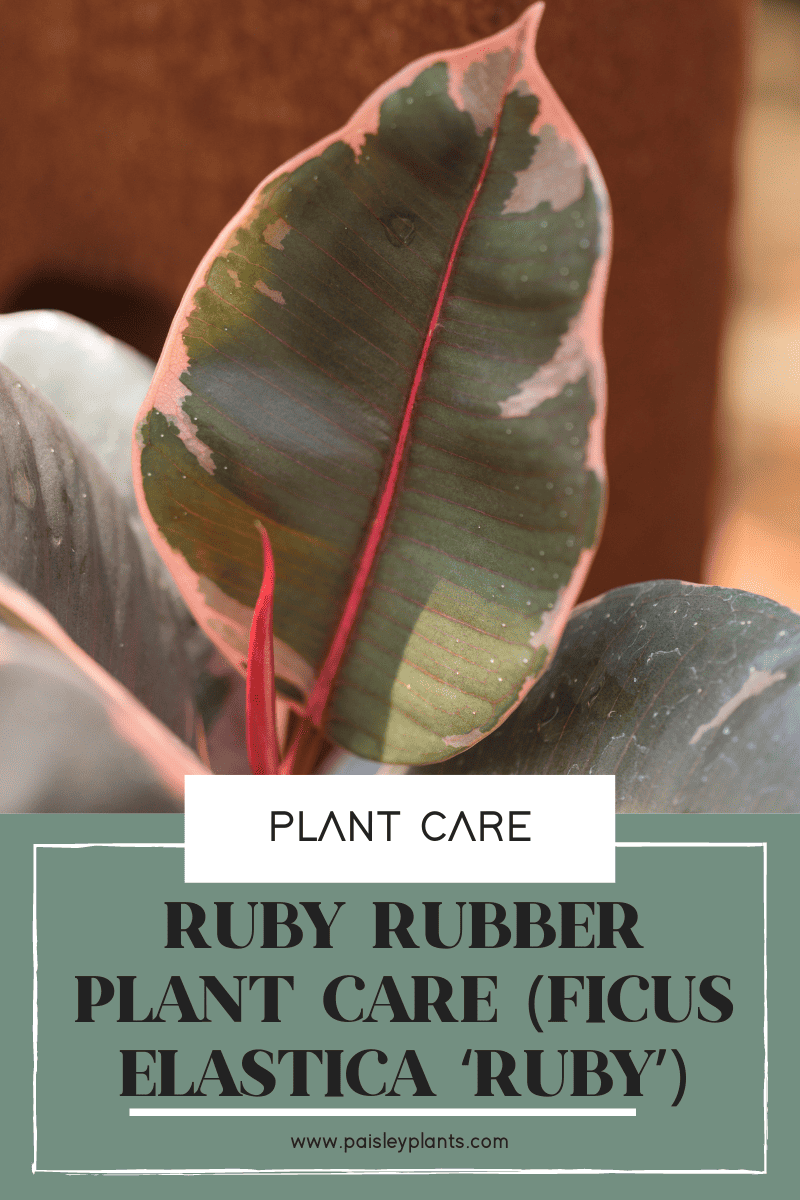
Table of Contents
Ruby Rubber Plant Care Background and History
This plant is native to the tropical regions of both India and Malaysia. It is also found in many other Southeast Asia countries and has also been introduced into the wild in places such as Hawaii, the West Indies, Sri Lanka, and Florida.
The Ficus Elastica ‘Ruby’ is also known as a Ruby Rubber Tree or a Variegated Rubber Plant.
There are many varieties of Rubber plants. This Ruby Rubber tree is just one of many varieties and is classified as the Ficus Elastica ‘Ruby.’ Sometimes rubber plants will be mislabeled when sold by garden centers, online or by other sellers, but it is nothing to get too worried about. The care is basically the same for all of them!
Toxicity
One thing to note about the Ficus Ruby Rubber tree is that even though it is toxic, it is only mildly so. The plant has a latex sap that when ingested or comes in contact with the skin, can cause skin irritation to various degrees, but rarely will cause any lasting damage.
Just keep this in mind when placing your plant near young children or pets in your home or office.
Ficus Elastica Ruby Plant Care Tips
Here’s how to care for your Ruby Rubber Tree!
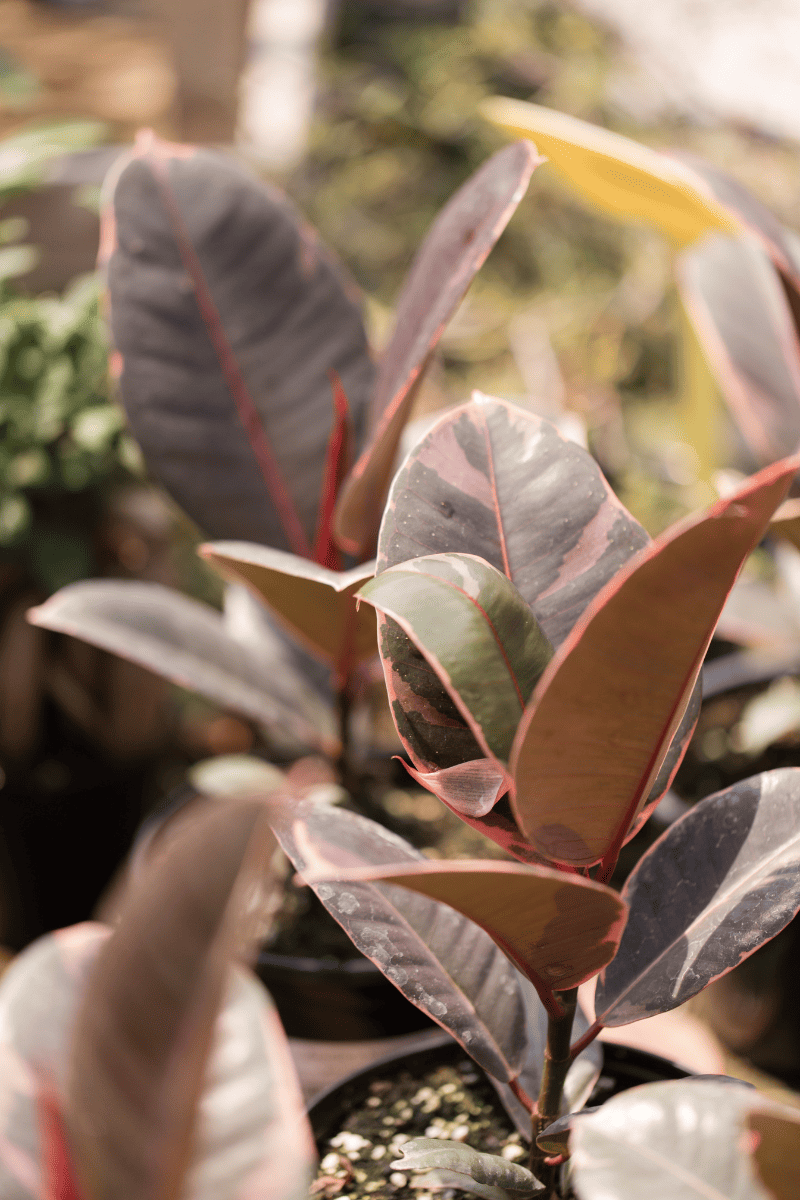
This post includes affiliate links.
Watering Requirements
Your Ruby Rubber plant is easier to maintain than some other types of plants with thinner leaves. The leaves maintain some of the moisture and the plant prefers somewhat moist soil, but not soaked.
A weekly watering is usually sufficient, but this will also depend upon the temperatures and light exposure your plant receives. It will also depend on the growing season. Plants grow slower during the winter months, so watering will need to slow down during this time.
Yellowing and falling leaves will definitely indicate you are overwatering your plant! It can lead to root rot and the death of your plant. Be sure to keep a regular watering schedule and always use a pot with a drainage hole so excess water can get out.
Light Requirements
For best results, give your Ruby Rubber plant a few hours of very early direct morning sunlight, followed by indirect light for the rest of the day. The leaves of these indoor plants will give off a ruby glow when exposed to over 8 hours of filtered light each day.
Too much direct bright light, however, for any length of time, will burn the leaves. They also won’t do well in low light conditions. Lighting conditions are very important to this colorful plant as they are very sensitive to location and don’t like being moved once they find a good home! Find a good place with ideal conditions, watch how it grows, then leave it there if it seems to flourish.
Soil Requirements
The best mix for your Ruby Rubber plant is one that has the ability to hold moisture long enough for the roots to absorb it. The soil mixture should not be dense or have moisture retaining crystals, so be sure to check the labels when using premixed potting soil.
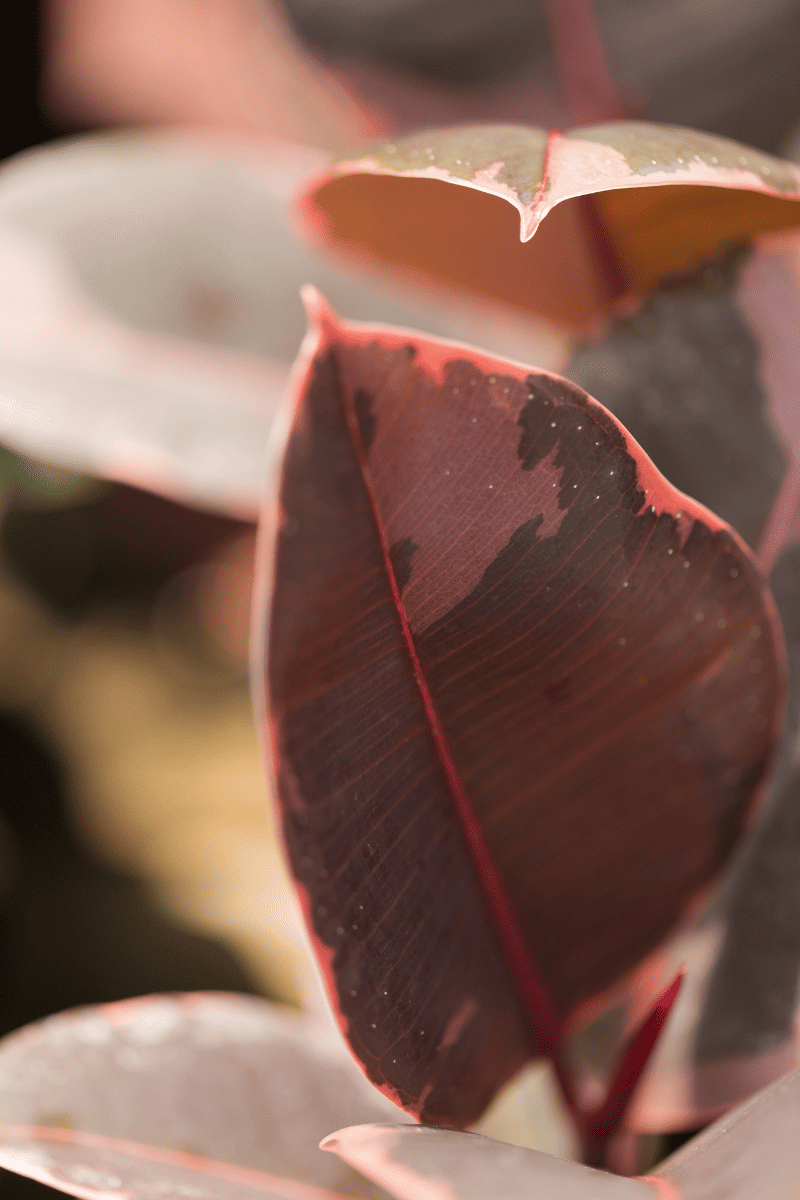
Nutrient rich loose soils are perfect mixtures such as using a ¼ part cactus soil with ¾ part potting soil to help with drainage. Be sure your pot has good drainage holes in the bottom so that water doesn’t sit in the bottom of the pot which can result in wet feet and potential root rot.
Fertilizer Requirements
It is a good idea to fertilize your Ruby Ficus Elastica once every six weeks with a diluted liquid fertilizer. It is recommended that you use a balanced fertilizer diluted to ¼ strength and that it be used during the spring and summer months only.
You should also keep track of how often you fertilize your ficus plants since over-fertilizing it can do more harm than good. Avoid fertilizing your plant during the winter months as this is a slow growing period and the unused fertilizer can cause leaf damage to your plant.
Temperature and Humidity Requirements
The optimum temperatures for Pink Rubber Plants are warm temperatures between 65 and 80 degrees F. Be careful that the temperature never gets below 55 degrees F for any length of time, however. This can cause the plant’s leaves to become misshapen and fall off!
The humidity requirements for your Ruby Rubber plant are fairly straightforward. Because they are tropical plants, they prefer a somewhat humid environment. To get high humidity in your home, you can add pebble trays filled with water underneath your plant or by using a cool mist humidifier in the room where you have your plant.
Pests and Diseases
There are several pests that Ruby Rubber plants are vulnerable to. These include aphids, mealy bugs, scale, spider mites, and thrips. If you see any of these pests on your plant, the first thing you need to do is isolate your plant from your other plants.
You will then need to treat the pests with something like neem oil or antibacterial soap. Follow the instructions on the package to use these products. It may take more than one treatment to rid your plant of the pests, but it will be worth it if you can get rid of them in a timely manner!
There are also certain types of blight that can infect your plant. The main cause of this is overwatering during the summer months.
The best way to prevent this is to use a sterilized planting medium when planting, avoid getting the leaves of your plant wet when watering, and watering sparingly. Prevention goes a long way!
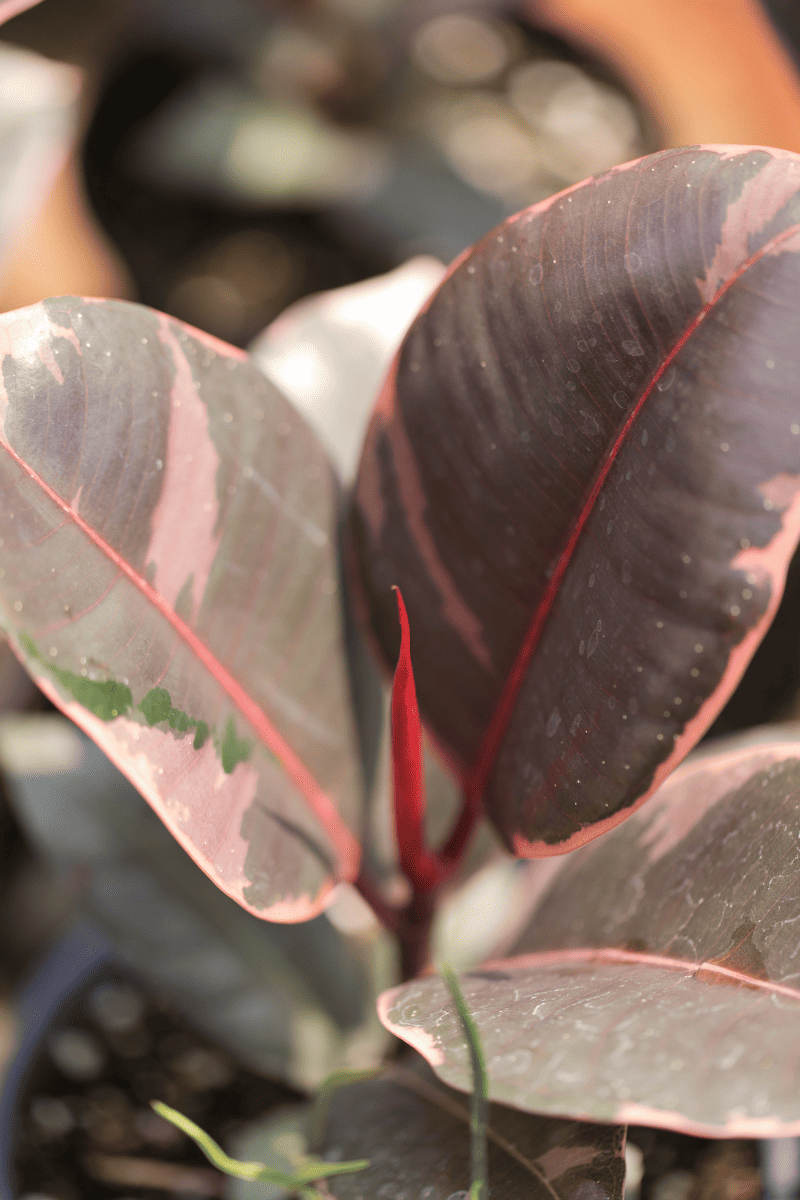
Pruning and Repotting
The main reasons to prune your Ruby Rubber plant are to contain growth, stimulate new growth, shape your plant into a new shape, if there are pests or diseases, or for propagating a new plant. When you do decide to prune your plant, you should remember the following things.
You can prune your plant any time of year, but winter is generally the best time for pruning. This is when the milky sap is flowing the least and it will secrete less sap. It also flows less during the evening hours than during the day, so this may be a good time to prune the leaves.
For propagation purposes, however, the springtime is the best time to prune your plant. Always use clean and sterile tools to prune the leaves. If you are pruning to contain growth, you can remove the entire crown of the plant without doing any harm.
If you are pruning to encourage growth, then you will need to decide where you want your plant to grow and remove leaves from that portion of the plant. This can be easily done just by looking at your plant and deciding what part needs to be trimmed back.
Some people like to trim their Ruby Rubber plants into topiaries. This can be done with instructions that can be found online or in a book. You will have to figure out what shape you want and then go from there to get it!
Once the roots begin poking through the bottom of the pot is a good time to repot your plant. When you do this will also depend on the climate you live in. Spring and early summer months are the best for colder climates, but winter months are fine in more temperate climates.
When you repot your plant, you will need a pot size that is no more than 1-2 inches larger than the old pot. Be sure to use new soil (as discussed above) that is appropriate for this type of plant.
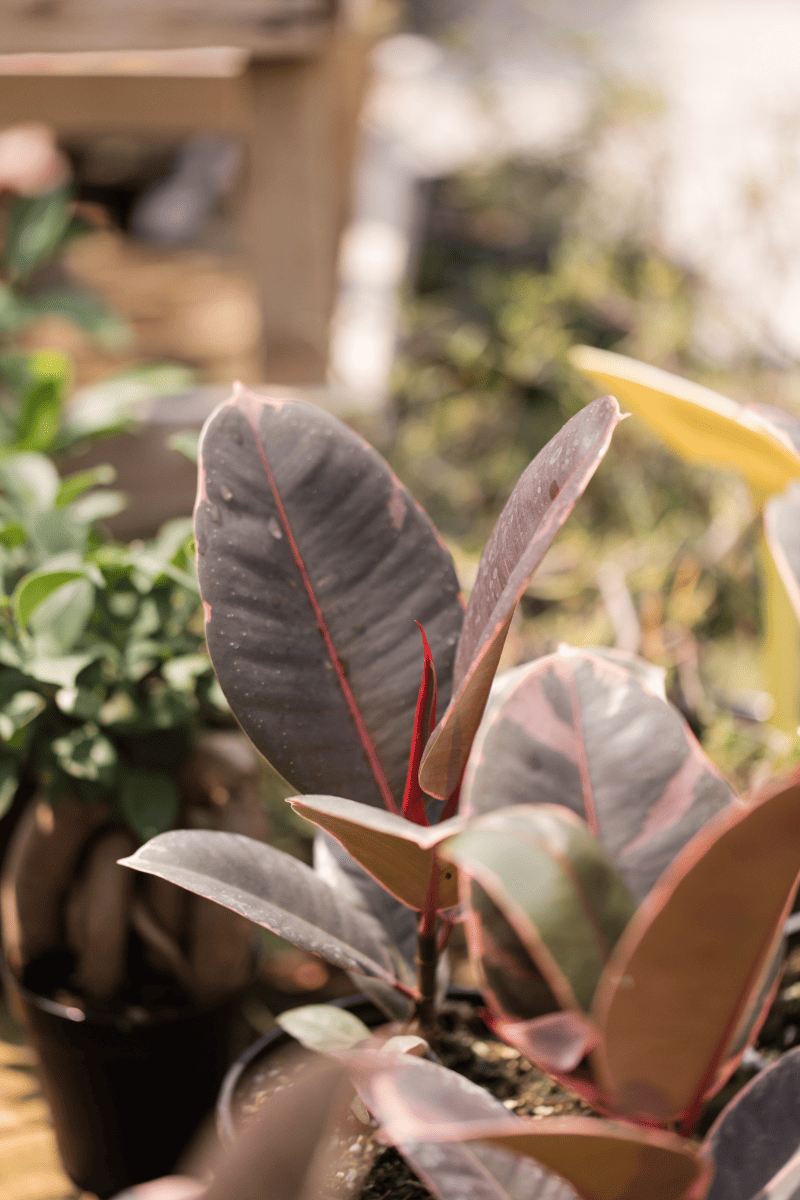
Common Problems
The majority of problems for your Ruby Rubber plant can be prevented by habits of care. One of the main ones is that you should be very careful to never overwater it! This is easily preventable by keeping a regular watering schedule.
When you see yellow leaves or mushy stems, this is a sign that you may have caused root rot by overwatering. If so, remove the plant from its pot, inspect the roots, and determine if the plant is salvageable. If they are turning black, you need to cut out all the affected roots, stems, and leaves. You can then repot with fresh soil.
When your plant starts dropping leaves, it can also be a sign of under-watering. The best way to keep your plant alive is to keep a regular watering schedule. Let the soil dry out slightly between waterings and this will give the roots some room to breathe.
Where to Buy
FAQs
You will need to keep your plant in bright, indirect light to maintain the pink color. Place it in front of an east facing window or a west or south facing window and keep it protected from intense direct afternoon sunlight.
You can put your plant in the shower to rinse it off or if this doesn’t work for you, you can clean each leaf off manually. This may take more time, but it will also ensure that each leaf is cleaned off well. The leaves are very prone to collecting dust and need to be kept clean to maintain their beautiful appearance. You can use a microfiber cloth and water to do this.
These plants only like a pot that is about an inch or so larger than their root ball, so be sure to not have it in too big a pot. When you repot your plant, only use a new pot that is about an inch or two larger than the old one. If you put it in too large a new pot, this will allow water to sit in the bottom of the pot and can lead to problems for the roots!
Owning one of these pretty plants may be something you are considering. It isn’t a real big deal to keep one alive or to maintain their beauty, so if you are thinking about it, go for it!
Following a few simple steps of care and maintenance should give you many years of enjoyment and add additional beauty to your home. As always, keep on growing!
If you want more rubber tree fun, check out this guide on how to care for a Rubber Plant!
Did you also know there’s a plant called a Baby Rubber Plant? It’s actually part of the Peperomia genus and not the Ficus but it’s still a really fun plant!
